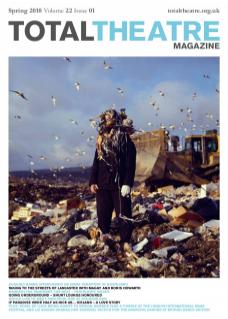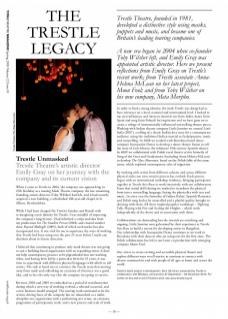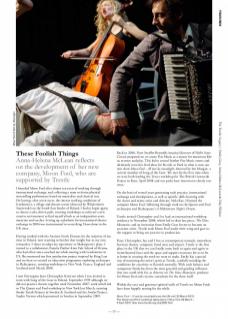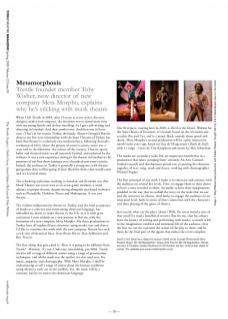Trestle Unmasked
Trestle Theatre’s artistic director Emily Gray on her journey with the company and its current vision.
When I came to Trestle in 2004, the company was approaching its 25th birthday as a touring Mask Theatre company, the last remaining founding artistic director (Toby Wilsher) had left, and it had recently acquired a new building, a refurbished 100-year-old chapel in St Albans, Hertfordshire.
While I had been charged (by Trestle’s funders and Board) with re-imagining a new identity for Trestle, I was mindful of respecting the company’s long history. I had inherited a script and idea from my predecessor for The Smallest Person (2004) and created another show Beyond Midnight (2005), both of which used masks but also incorporated text. It was vital for me to experience the ways of working that Trestle had been using over the past 25 years before I made any decisions about its future direction.
I believed that continuing to produce only mask theatre was not going to suit a building-based organisation with an expanding remit. It does not help contemporary practice to be pigeonholed into one working ethos, and having been led by a particular form for 25 years, it was time to experiment with different physical languages with which to tell stories. The task at hand was to convince the Trestle team that moving away from mask and embarking on a journey of discovery was a good idea, and in fact the only way that the company was going to survive.
Between 2006 and 2009 we embarked on a period of transformation during which a new way of working evolved, a rebrand occurred, and a new business model emerged. The touring work continued to be the artistic driving force of the company but we relaunched as a multidiscipline arts organisation with a performing arts venue, an extensive programme of participatory work, and a new process and style of work.
In order to find a strong identity, the work Trestle was doing had to have relevance on a local, national and international level. I looked to my own influences and interests (martial arts from India, dance from Spain and song from Poland) for inspiration and we have gone on to create a trilogy of internationally influenced storytelling-theatre pieces. Working with Indian theatre company Little Jasmine we created Little India (2007), a telling of a classic Indian love story for a contemporary audience, using the traditional Indian martial art kalaripayattu, music and storytelling. In 2008 we worked with Barcelona-based dance company Increpación Danza to develop a dance theatre fusion to tell the story of Lola Montez; the infamous 19th century Spanish dancer. In 2009 we collaborated with Polish vocal theatre artists formerly of Song of the Goat and Gardizienice (including Anna-Helena McLean) to develop The Glass Mountain, based on the Polish fable of the same name, which explored contemporary tales of migration.
By working with artists from different cultures and across different physical styles our own creative process has evolved. Each process began with an international workshop residency, bringing participants together at Trestle Arts Base to work intensively with our collaborators. From that initial skill sharing we worked to transform the physical form into a storytelling language, fusing the physicality with text and music. In every case the formality of Indian Kalari, Spanish Flamenco and Polish song had to be unravelled and a playful quality brought to devising with them. All three inspired popular workshops – Fighting Talk, Playing with Fire and Scaling the Heights – which work independently of the shows and in association with them.
Collaborations are demanding but the rewards are enriching and ongoing. Little Jasmine were galvanised by their experience at Trestle Arts Base to build a retreat for developing artists in Bangalore. Our relationship with Increpación Danza continues as we work in Barcelona with their dancers who are using text for the first time. The Polish collaboration has led to our latest co-production with emerging company Moon Fool.
Our aim is to create exciting and accessible physical theatre and explore different ways to tell stories; to continue to connect with diverse communities and with people of all ages at home and across the world.
Trestle’s latest project in development, Burn My Heart, presented by Trestle in collaboration with Blindeye, will premiere 27 September – 30 November 2010. For further on this and on all of Trestle’s work, see www.trestle.org.uk
These Foolish Things
Anna-Helena McLean reflects on the development of her new company, Moon Fool, who are supported by Trestle.
I founded Moon Fool after almost ten years of working through international exchange, and collecting a team to devise physical storytelling performance based on musicality and classical text. On leaving, after seven years, the intense working conditions of Gardzienice, a village and theatre centre (directed by Wlodzimierz Staniewski) on the South East border of Poland, I had to begin again; to choose a solo-driven path, running workshops to cultivate a new creative environment to find myself afresh as an independent actor, musician and teacher. Setting up a platform for international theatre exchange in 2004 was instrumental to everything I have done in the UK since.
Having worked with the Ancient Greek Dramas for the majority of my time in Poland, now wanting to further that insight but in my own vernacular, I chose to adapt my experience to Shakespeare’s plays. I turned to a collaborator, Pamela Prather from Yale School of Drama, who had often voice-coached me while touring with Gardzienice in US. She mentored my first production project inspired by King Lear and we then co-created an education programme exploring archetypes in Shakespeare, running workshops in New York, France, England and Scotland until March 2008.
I met Norwegian born Christopher Sivertsen when I was invited to train with Song of the Goat in Poland, September 1999 although we did not practice theatre together until November 2007: work which led to The Queen and Fool workshop in New York last March, running Awake Youth Projects in Sweden & Scotland and the Awake Project: Studio Version which premiered in Sweden in September 2009.
Back in 2006, Peter Swaffer-Reynolds (musical director of NoFit State Circus) proposed we co-create Fire Music as a means for musicians like us to meet and play. This led to several further Fire Music events and ultimately served to feed ideas for his role as Puck in what is now our new show Moon Fool – Ill met by moonlight, directed by Ian Morgan, a current member of Song of the Goat. We met for the first time when we were both leading the Traces workshop for The British Grotowski Project in Kent, April 2008 and our paths have interwoven closely ever since.
On the basis of several years generating such practice, international exchange and development, as well as specific skills learning with the clown and mime artist and director, Nola Rae, I formed the company Moon Fool, following through work on the Queen and Fool archetypes and Shakespeare’s A Midsummer Night’s Dream.
Trestle invited Christopher and I to lead an international workshop residency in November 2008, which led to their last piece, The Glass Mountain, and an invitation from Emily Gray for me to become an associate artist. Trestle took Moon Fool under their wing and gave us the support to bring our practice to production.
Peter, Christopher, Ian and I live as contemporary nomads, somewhere between theatre, computer, loved ones and airport. Trestle is the first place in the UK that we can finally come back to again and again to warm-hearted faces and the space and support necessary for us to be at home in creating the work we want to make. Emily has a special way of nurturing the artist’s spirit at Trestle, carefully minding the conditions for creativity to flourish naturally. With such balance and composure Emily has been the most graceful and goading influence that one could wish for, as director on The Glass Mountain, producer for Moon Fool and creative consultant for the show itself.
Within the cosy and generous-spirited walls of Trestle we Moon Fools have been happily nesting for the while.
Moon Fool – Ill met by moonlight tours the UK until 30 March 2010. The Queen and Fool workshop takes place in New York 29 March – 3 April 2010. See www.trestle.org.uk/pl262.html
Metamorphosis Trestle
Founder member Toby Wisher, now director of new company Meta Morpho, explains why he’s sticking with mask theatre.
When I left Trestle in 2004, after 23 years as actor, writer, director, designer, maker and composer, the intention was to spend more time with my young family and do less travelling. So I got a job writing and directing in Istanbul. And then another one. And then one in Erzurum. (That’s in far-eastern Turkey, obviously. Almost Georgia!) But the draw to my five-year relationship with the State Theatres of Turkey has been that theatre is a relatively new medium there, following Ataturk’s revolution of 1923, where the pursuit of western artistic tastes was a state tool to ‘de-Islamisise’ the culture of the country. Theatre, opera, ballet and classical music are all massively funded, and endorsed by the military. It was a new experience sitting in the theatre in Istanbul at the premiere of my first show amongst over a hundred new army recruits. Indeed, the audience in Turkey is generally a young one, with theatregoing often akin to film-going. If they liked the show, they would come and see it several times.
The refreshing realisation working in Istanbul and Erzurum was that Mask Theatre was never seen as an avant-garde medium, a weird adjunct to proper theatre, despite sitting alongside text-based stalwarts such as Pirandello, Chekhov, Pinter and Shakespeare. It was just theatre…
The evident enthusiasm for theatre in Turkey, and the total acceptance of masks as a relevant and entertaining theatrical language, has rekindled my desire to make theatre in the UK, so it is with great excitement I now embark on a new journey in Britain, with the formation of a new company, Meta Morpho. My three productions in Turkey have all explored farce structure, using masks, text and dance. I’d like to continue this work with the new company. Britain has such a rich vein of theatrical farce, from Brian Rix to Alan Aykbourn and Ben Travers.
The first thing that gets asked is: ‘How is it going to be different from Trestle?’ Hmmm. It’s not. Under my stewardship, pre-2004, Trestle tried to tell a range of different stories using a range of presentation techniques, and whilst mask was the unifier, we also used text, live music, puppetry and choreography. With Meta Morpho, I shall be endeavouring to tell a range of stories about the human condition using whatever tools are in the toolbox. Yes, the mask will be a constant, but by no means the dominant language.
Our first piece, touring later in 2010, is Devil in the Detail. Written for the State theatre of Erzurum, it is loosely based on the Victorian one-act play Box and Cox, and is a manic black comedy about greed and deceit. Meta Morpho’s second production will be a play (written by myself some years ago, based on Guy de Maupassant’s Boule de Suif), with 11 songs – lyrics by Tim Knapman and music by Alex Silverman.
The masks are secondary tools, but are important nonetheless in a production that takes ‘jumping form’ seriously. An Arts Council-funded research and development period saw us putting the elements together, of text, song, mask and dance, working with choreographer Michael Popper.
The first principal of any work I make is to entertain and connect with the audience on several key levels. First, to engage them in their desire to have a story revealed to them. Secondly, to have their imaginations prodded in the way that we unfold the story, in the tools that we use and the structure we choose. And lastly, to engage the audience on an emotional level, both in terms of their connection with the characters and their playing of the game of theatre.
Just exactly what are the plays ‘about’? Well, I’m never entirely sure of that until I’ve read a handful of reviews. But for me, that has always been the beauty of writing and performing with masks: so much is left to the imagination, intellect and emotional life of the audience, that the best we can do is present the action of the play to them, and let them be the final part of the jigsaw that makes the event complete.
Devil in the Detail tour dates for autumn 2010 so far include Portsmouth New Theatre Royal, 22–23 September; Jersey Arts Centre 28–29 September; Goole Junction 2 October; Exeter Northcott 4–6 October (all tbc, with further dates to come). For updates see www.metamorpho.co.uk



